Welcome! Ready to explore Stuttgart? This dynamic city, nestled in the heart of Germany’s Baden-Württemberg region, seamlessly combines rich history with cutting-edge innovation. Known as the cradle of the automobile, Stuttgart is not only the home of Mercedes-Benz and Porsche but also a city of lush green spaces, vibrant festivals, and a flourishing arts scene. Whether you’re a car enthusiast, a nature lover, or a culture vulture, Stuttgart has something exciting for you.
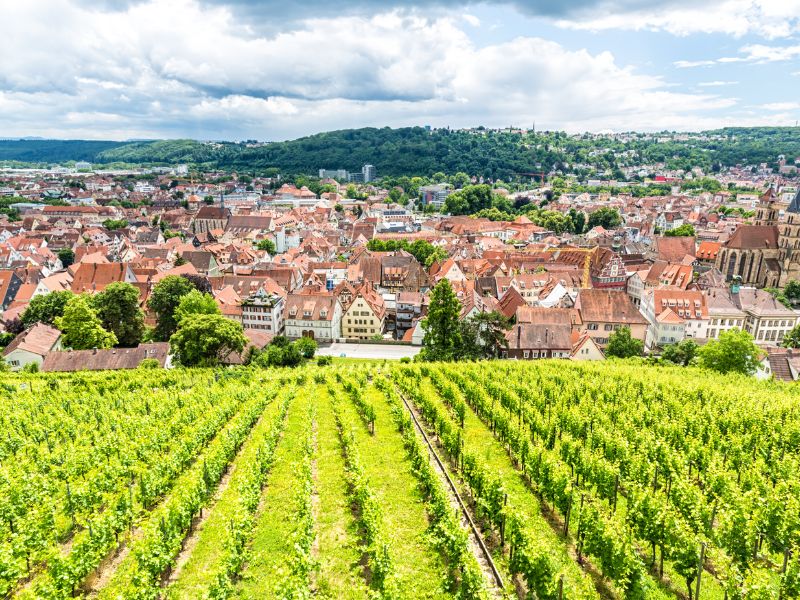
Discover the City’s Heartbeat
A City of Innovation and Tradition Stuttgart’s storied past as an industrial powerhouse is just the beginning. Dive into its automotive heritage at the Mercedes-Benz Museum or get a glimpse of the future at the Porsche Museum. Not just about cars, the city’s historical layers peel back to reveal palatial architecture like the Altes Schloss and the Neues Schloss, standing majestically in the Schlossplatz.
Green Escapes
Parks and Recreation Need to breathe in some fresh air? Stuttgart’s many parks and gardens offer a verdant escape from the urban rush. Head to the Killesberg Park for a leisurely stroll or enjoy a boat ride on the Max-Eyth-See. The city’s position in a valley surrounded by vine-covered hills also provides ample hiking opportunities just minutes from the city center.
Cultural Richness
Feast of Festivals Stuttgart loves to celebrate, and its cultural calendar is brimming with events. From the colorful Stuttgart Spring Festival to the intoxicating Cannstatter Volksfest, there’s always something happening. Winter brings the magical Stuttgart Christmas Market, one of Europe’s largest and oldest, lighting up the city’s squares and alleys with festive cheer.
Savor the Local Flavors
A Culinary Journey Indulge in the flavors of Swabian cuisine; hearty, delicious, and distinctly German. Must-try dishes include Maultaschen (Swabian ravioli) and Spätzle (egg noodles), perfect with a local wine from the surrounding vineyards. And yes, the beer here is just as good as you’d expect—this is Germany, after all!
Why Stuttgart? Stuttgart’s unique blend of automotive heritage, scenic landscapes, and vibrant cultural scene makes it a fascinating destination for travelers. Each visit peels back a layer, revealing an intricate mosaic of experiences. So pack your curiosity and a good pair of walking shoes, and prepare to be captivated by the charm and spirit of Stuttgart. Whether it’s your first visit or your tenth, the city is ready to unfold its treasures just for you. Welcome to Stuttgart—let your adventure begin!
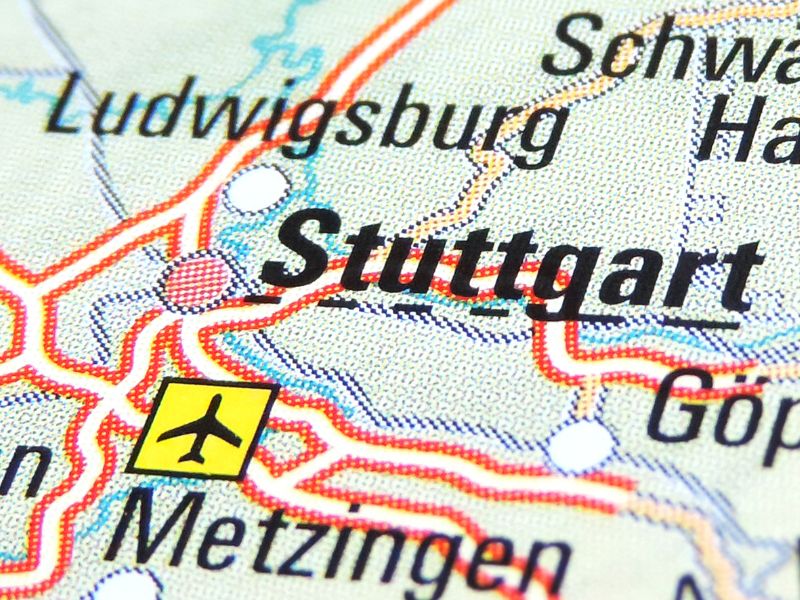
Stuttgart City Guide: A Brief History Of Stuttgart, Germany
Grab a cup of coffee, and let’s travel back in time. Stuttgart, now a bustling metropolis, began its humble origins as a stud farm (“Stuotgarten”) for breeding warhorses in the 10th century. This small settlement evolved through the ages into the vibrant city known today, renowned for its cultural richness and industrial prowess.
From Horses to Ducal Power
The Birth of a City In the early Middle Ages, Stuttgart’s strategic location in the fertile Neckar valley helped it grow from a horse-breeding village into a thriving agricultural town. By the 14th century, it caught the eye of the Counts of Württemberg, who saw its potential as a political stronghold. They established Stuttgart as their ducal seat, setting the stage for its rise to prominence.
A Ducal Capital The city’s status as the capital of the Duchy of Württemberg brought wealth and a flourishing Renaissance culture. Magnificent castles such as the Altes Schloss and the grand Neues Schloss were constructed, which today stand as symbols of Stuttgart’s regal past. Under ducal stewardship, the city became a center of arts and culture—a legacy that continues to enrich its modern identity.
Industrial Revolution and Beyond
On the Fast Track to Modernity The 19th century ushered in the Industrial Revolution, and Stuttgart was quick to get on board. It transformed into an industrial hub, setting foundations for what would become its global automotive fame. The establishment of automotive giants like Mercedes-Benz and Porsche in the early 20th century marked a new era of innovation and growth.
War and Reconstruction World War II brought significant destruction to Stuttgart, but the post-war years were a testament to the city’s resilience. The rebuilding period was marked by innovative urban planning and architectural experimentation, making Stuttgart a showcase of modernist ideas and a symbol of the Wirtschaftswunder, Germany’s economic miracle.
Stuttgart Today
A Thriving Urban Tapestry Today, Stuttgart stands as a testament to its layered history, blending historical architecture with modern infrastructure. It’s a hub for both cultural and automotive enthusiasts, offering museums, theaters, and opera houses alongside its famous car museums. The city’s green spaces and vineyards drape the urban landscape, offering escapes within the city limits.
Cultural Legacy Continues Festivals and fairs throughout the year celebrate everything from wine to Christmas, drawing visitors from across the globe. The Cannstatter Volksfest, rivaling Oktoberfest in size and fun, showcases the city’s love for tradition and partying—a tradition as old as the city itself.
Forward-Thinking Stuttgart With its commitment to innovation and sustainability, Stuttgart is not just living in the past but also driving towards a future where tradition meets modernity head-on. This city knows where it’s been and definitely knows where it’s going. Ready to explore more?
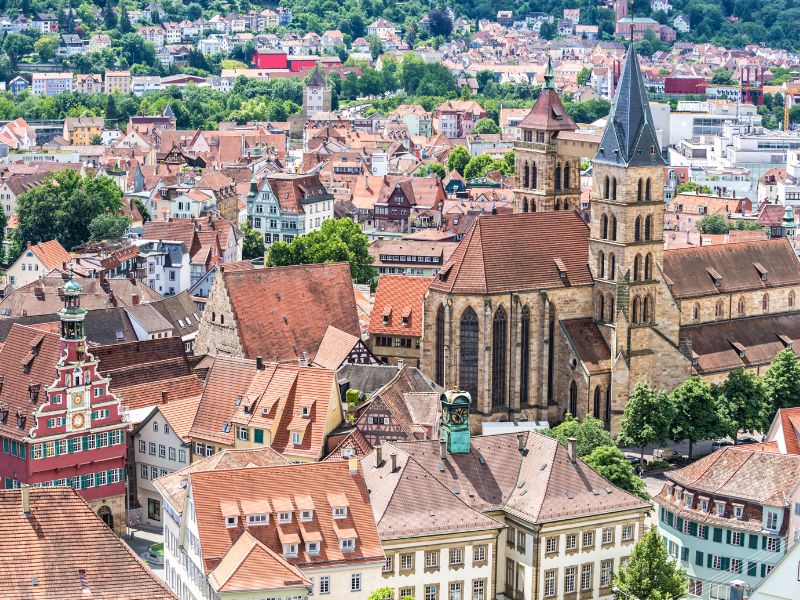
Stuttgart Top Attractions and Best Places to Visit in Germany
Mention Stuttgart to a German car enthusiast, and their eyes will light up. That’s because this city, despite its tranquil appearance, is home to two auto giants – Mercedes Benz and Porsche. If you love fast cars, don’t miss this destination.
Begin your time in Stuttgart by visiting the Mercedes Benz Museum. This institution pays homage to the automobile brand that calls this city home. Before walking in, appreciate the building itself. From the moment you arrive, its post-modernist curves steal the show.
Within, you’ll find 160 vehicles, dating from the earliest models to the most recent. Get a free audio guide when you arrive – it will fill in details you might not already know. If you have time, tour the Untertürkheim engine factory, which allows a look at this company’s manufacturing process.
Stuttgart is also home to the Porsche. Not to be outdone by their rivals, they also offer an attraction – the Porsche Museum. Since 2009, this institution has offered more than 80 exhibits showing off Porsche models from various eras.
More Attractions
Here, you’ll find everything from street-legal cars to Formula 1 machines. As with the Mercedes Benz Museum, the Porsche Museum offers audio guides in various languages. Take one, as it’ll teach you things that you’d never know otherwise.
Art lovers will not want to miss a visit to Staatsgalerie. Once an art museum of only regional significance, a change in focus in the 1980s changed everything. Today, critics regard it as one of Europe’s finest collections of art.
Here, there are two main focuses – European classics and modern art. In the old gallery, you’ll find German and Italian works dating back to the 14th century. In the new gallery, you’ll find modern art from artists like Picasso, Schlemmer, and Beuys.
Around the holidays, make an effort to attend the Stuttgart Christmas Market. Every year, more than three million come here to buy crafts, drink gluhwein, and listen to carols. Feel free to join and share in their merriment.
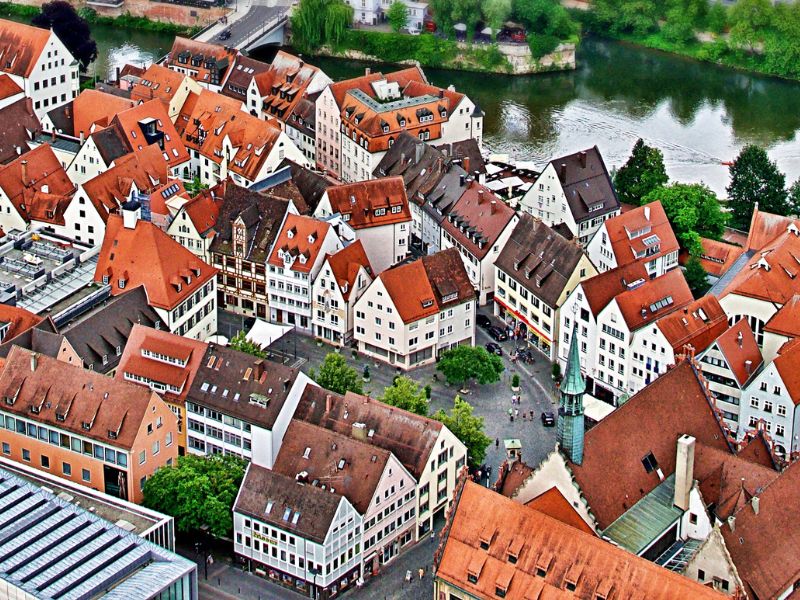
Other Cultural Attractions: Trip to Stuttgart, Germany
Love soccer/football? If possible, attend a match at the Mercedes Benz Arena. During the Bundesliga season, this stadium is home to VfB Stuttgart. If you’re not familiar with German football, Bundesliga is equivalent to the English Premier League in the United Kingdom.
Usually, this arena plays host to as many as 60,000 spectators. However, back in 1950, its attendance record was a stunning 97,553 during an international match between Germany and Switzerland. When this building isn’t hosting football-crazed fans, it also holds concerts. In the past, bands such as Depeche Mode and Pink Floyd have packed this venue.
Scope out amazing views from the top of Fernsehturm Stuttgart. Standing 700 feet above the surrounding landscape, the vistas from its observation deck are gobsmacking. Not only can you get views over Stuttgart, but views of distant mountains are also possible.
Other Attractions
Up here, there are plenty of amazing photo opportunities. However, be sure to bring a warm jacket, as winds up here can get pretty stiff.
If you are travelling as a family in the Stuttgart area, add the Wilhelma Zoologisch-Botanischer Garten to your list. The creators of this combination botanical garden/zoo located it on the grounds of a former castle. This decision has given this place an ambience that places it above competing attractions in Germany.
Here, you’ll find 1,200 species of animal, plus 6,000 different plants from around the world. This park also includes an aquarium, where you’ll find sea lions and other marine species.
During your Stuttgart explorations, take some time to chill out in Höhenpark Killesberg. This giant public park, which spans over 123 acres, contains not just flower beds, but monuments, an observation tower, and even a mini-railway. If you just want to relax, find the beer garden and watch the world go by.
What To Eat
If you’re visiting Stuttgart at a chilly time of year, warm up with some Gaisburger Marsch. This beef stew, which originated in Stuttgart, contains cubed beef and a medley of vegetables. Chefs slow-cook this hearty meal for hours, producing a rich flavour you won’t want to miss.
More in the mood for pasta? Then find a restaurant that serves Schwäbische Maultaschen. Cooks start by stuffing these pasta dumplings with minced beef/pork, bread crumbs, and spinach. Then, they either fry it in oil with egg, or they cook it in broth. No matter how they prepare it, this dish will make you feel whole.
Lastly, get a Schwarzwälder Kirschtorte for dessert. Translating to English as Black Forest Cake, this dark chocolate and cherry cake is a beloved local’s favourite. And if you’ve never had it before, it will soon become yours.
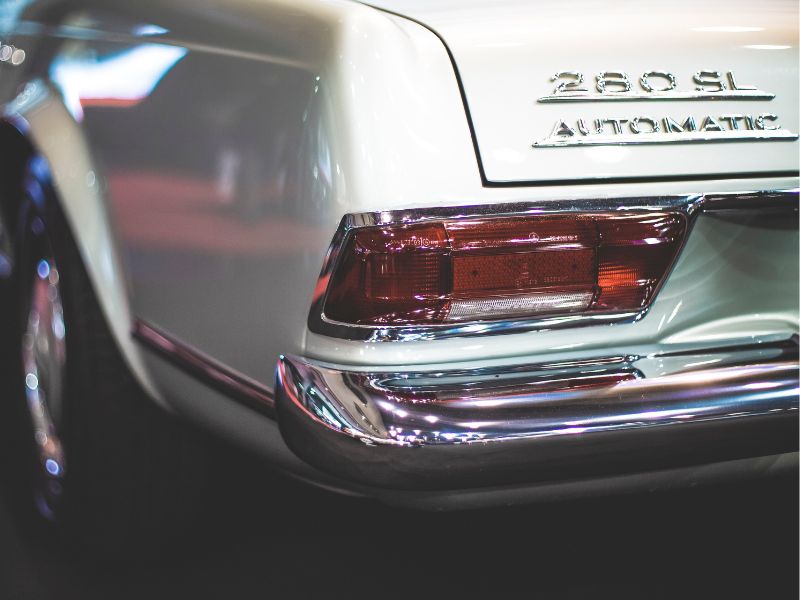
Top 30 Things To Do in Stuttgart, Germany For Visitors
Here are the top 30 things to do in Stuttgart:
source: Kostandiina on YouTube
1. Visit the Mercedes-Benz Museum
Immerse yourself in automotive history at the Mercedes-Benz Museum, where over 160 vehicles are showcased, ranging from the earliest models to cutting-edge concept cars. The museum’s innovative architecture mirrors the forward-thinking designs of the cars it houses, making the experience visually stunning. As you walk through the exhibits, you’ll explore the evolution of the automobile and Mercedes-Benz’s pivotal role in shaping it. It’s a must-visit for car enthusiasts and history buffs alike.
- Extensive collection: Discover over 160 vehicles spanning Mercedes-Benz’s rich history.
- Innovative architecture: Experience a museum designed as impressively as the cars it displays.
- Educational journey: Learn about the evolution of automobiles and Mercedes-Benz’s contributions.
2. Explore the Porsche Museum
Step into the thrilling world of high-performance engineering at the Porsche Museum, where the legacy of Porsche vehicles comes to life. The museum’s modern architecture is a sight to behold, featuring dynamic designs that reflect the brand’s innovative spirit. Interactive exhibits and rare prototypes provide a deep dive into Porsche’s engineering and design philosophy. Guided tours offer fascinating insights into the brand’s storied legacy, making it an essential stop for any car lover.
- Iconic models: View legendary Porsche vehicles, including the iconic 911.
- Modern design: Marvel at the museum’s contemporary and dynamic architectural style.
- Interactive exhibits: Engage with hands-on displays and rare prototypes.
3. Enjoy the Wilhelma Zoo and Botanical Garden
Discover a unique blend of wildlife and botanical beauty at Wilhelma Zoo and Botanical Garden, one of Europe’s largest zoological-botanical gardens. Home to over 1,200 species, the park boasts a wide variety of animals and an impressive collection of plants from around the world. The historical Moorish architecture adds a distinctive charm, enhancing the overall experience. With themed gardens, an aquarium, and terrariums, Wilhelma is a perfect day out for families and nature lovers.
- Diverse species: Encounter over 1,200 species of animals and a vast array of plants.
- Historic charm: Explore Moorish-style architecture that adds unique character.
- Themed attractions: Enjoy themed gardens, aquariums, and terrariums for varied experiences.
4. Stroll Around Schlossplatz
Experience the vibrant heart of Stuttgart at Schlossplatz, the city’s largest square surrounded by historic buildings and lush gardens. It’s a bustling gathering spot for both locals and tourists, hosting numerous events and festivals throughout the year. Notable landmarks like the New Palace (Neues Schloss) and the Jubilee Column add to the square’s charm. Whether you’re enjoying a leisurely walk or people-watching from a café, Schlossplatz offers excellent opportunities for relaxation and exploration.
- Central hub: Enjoy the lively atmosphere of Stuttgart’s largest square.
- Historic landmarks: Admire the New Palace and Jubilee Column.
- Event venue: Participate in various events and festivals held throughout the year.
5. Visit the Staatsgalerie Stuttgart
Delve into the world of art at the Staatsgalerie Stuttgart, an acclaimed art museum boasting an extensive collection from the Middle Ages to contemporary works. Its modern wing, designed by British architect James Stirling, stands out as a masterpiece of postmodern architecture. The museum houses masterpieces by European artists such as Picasso, Rembrandt, and Dürer, offering a rich and diverse artistic experience. Temporary exhibitions complement the permanent collection, ensuring there’s always something new to discover.
- Extensive art collection: Explore works ranging from the Middle Ages to contemporary art.
- Architectural marvel: Appreciate the museum’s postmodern design by James Stirling.
- Masterpieces on display: View works by renowned artists like Picasso and Rembrandt.
6. Tour the Old and New State Parliament Buildings
Witness Stuttgart’s architectural evolution by touring the Old and New State Parliament Buildings, showcasing a harmonious blend of tradition and modernity. Guided tours provide insights into Baden-Württemberg’s political history and the architectural significance of these iconic structures. The New State Parliament features a unique, transparent design that symbolizes openness and democracy. Exploring these buildings offers a deeper understanding of the region’s legislative processes and political development.
- Architectural contrast: Explore the blend of historic and modern architectural styles.
- Educational tours: Learn about the political history and legislative processes.
- Symbolic design: Admire the New Parliament’s transparent architecture representing openness.
7. Experience the Cannstatter Volksfest
Join the festivities at the Cannstatter Volksfest, one of Stuttgart’s largest and most traditional festivals. This lively event features thrilling rides, spacious beer tents, and an array of Swabian delicacies that delight food lovers. Held annually in the fall, the festival attracts millions of visitors from around the globe, offering a vibrant atmosphere similar to Oktoberfest but with a distinctly local flavor. The fruit column, a symbol of the Volksfest, stands tall amidst the celebrations, representing a bountiful harvest.
- Thrilling rides: Enjoy a variety of amusement rides for all ages.
- Beer tents: Indulge in local brews and traditional Swabian cuisine.
- Festive atmosphere: Experience the lively and welcoming vibe of one of Germany’s biggest festivals.
8. Relax in Killesberg Park
Escape the urban hustle and unwind in Killesberg Park, known for its stunning landscapes, water features, and vibrant flower gardens. The park also boasts a charming miniature railway that delights both children and adults, providing a fun way to explore its expansive grounds. Various sculptures and artworks are scattered throughout, adding an artistic touch to the natural beauty. Seasonal events, including light shows and garden exhibitions, enhance the park’s allure, making it a perfect spot for relaxation and leisure.
- Beautiful landscapes: Wander through meticulously maintained gardens and scenic paths.
- Miniature railway: Enjoy a charming train ride around the park.
- Artistic elements: Discover sculptures and artworks integrated into the natural setting.
9. Discover the Stuttgart City Library
Marvel at the architectural brilliance of the Stuttgart City Library, renowned for its striking cube-shaped design and pristine all-white interior. This modern library is a haven for book lovers, offering an extensive collection of books, media, and quiet reading spaces spread over nine floors. Regular events, workshops, and exhibitions make it a cultural hub for the community. Don’t forget to visit the rooftop terrace, which provides stunning panoramic views of the city skyline.
- Architectural gem: Admire the cube-shaped design and minimalist interior.
- Extensive resources: Access a vast collection of books and media for all interests.
- Cultural events: Participate in workshops, exhibitions, and community events.
10. Visit the Solitude Palace
Step back in time at the Solitude Palace, a magnificent 18th-century Rococo palace located on Stuttgart’s outskirts. The palace offers stunning views of the surrounding landscape, making it a perfect spot for photography and leisurely walks. Meticulously preserved, the interior showcases the opulence of the era, with lavish furnishings and exquisite decorations. The expansive Solitude Park surrounding the palace is ideal for a peaceful stroll or a picnic, providing a serene escape from the city.
- Historic elegance: Explore the beautifully preserved Rococo architecture and interiors.
- Scenic views: Enjoy breathtaking vistas of the surrounding countryside.
- Expansive park: Relax and wander through the tranquil gardens and walking paths.
11. Explore the Ludwigsburg Residential Palace
Just north of Stuttgart, the Ludwigsburg Residential Palace stands as one of Europe’s largest Baroque palaces, renowned for its lavish interiors and expansive gardens. The palace hosts a variety of festivals, concerts, and events throughout the year, adding to its vibrant cultural scene. Visitors can explore its diverse museums, including the Fashion Museum and the Ceramics Museum, which offer fascinating insights into different art forms. The Fairy Tale Garden is a delight for families, featuring whimsical landscapes and playful sculptures.
- Baroque grandeur: Admire the opulent architecture and ornate interiors.
- Diverse museums: Explore specialized museums showcasing fashion and ceramics.
- Family-friendly attractions: Enjoy the enchanting Fairy Tale Garden with interactive elements.
12. Enjoy the Stuttgart Ballet
Experience world-class performances at the Stuttgart Ballet, one of the most prestigious ballet companies globally. Known for its innovative choreography and outstanding dancers, the ballet company consistently delivers captivating performances that blend classic and contemporary styles. Attending a show at the Stuttgart Opera House is an unforgettable cultural experience, highlighting the city’s vibrant arts scene. For a deeper appreciation, consider taking a behind-the-scenes tour to see the dedication and artistry that go into each performance.
- Prestigious performances: Watch acclaimed ballets performed by top-tier dancers.
- Innovative choreography: Enjoy a blend of classic and modern ballet styles.
- Behind-the-scenes tours: Gain insights into the ballet company’s creative process.
13. Hike in the Schönbuch Nature Park
Embrace the great outdoors at the Schönbuch Nature Park, located just south of Stuttgart. This vast forested area is perfect for hiking, cycling, and wildlife watching, offering well-marked trails and scenic viewpoints. The park is home to diverse flora and fauna, including deer and wild boars, providing ample opportunities for nature enthusiasts to observe wildlife. Guided nature walks and educational programs are available, making it an engaging experience for all ages.
- Vast trails: Explore numerous hiking and cycling paths suitable for all levels.
- Wildlife encounters: Spot deer, wild boars, and a variety of bird species.
- Educational programs: Participate in guided walks and learn about local ecology.
14. Discover the Württemberg State Museum
Delve into the rich history of the region at the Württemberg State Museum, housed in the historic Old Castle (Altes Schloss). The museum offers a comprehensive journey through time, showcasing artifacts from prehistoric times to the present day. Exhibits include archaeological finds, medieval art, and royal treasures that highlight Stuttgart’s cultural and historical heritage. Interactive displays and special exhibitions make the museum engaging for visitors of all ages, providing a deeper understanding of the region’s past.
- Comprehensive exhibits: Explore artifacts and artworks spanning centuries.
- Historic setting: Visit the museum within the majestic Old Castle.
- Interactive displays: Engage with hands-on exhibits and informative presentations.
15. Visit the Stuttgart TV Tower
Ascend the Stuttgart TV Tower, the world’s first television tower built from concrete, for unparalleled panoramic views of the city and surrounding areas. The observation deck offers breathtaking vistas, making it a popular spot for photography and sightseeing. Inside, the tower features a café and a restaurant where you can enjoy a meal with a view. As an iconic landmark of Stuttgart, the TV Tower is a testament to modern engineering and a must-see attraction.
- Panoramic views: Enjoy sweeping vistas of Stuttgart and the surrounding landscape.
- Iconic structure: Admire the innovative design of the world’s first concrete TV tower.
- Dining with a view: Relish a meal or drink at the tower’s restaurant with stunning scenery.
16. Explore the Weissenhof Estate
Step into the world of modern architecture at the Weissenhof Estate, a UNESCO World Heritage site that showcases pioneering designs from the 1920s. This estate features buildings designed by renowned architects like Le Corbusier and Mies van der Rohe, representing the “New Building” movement. Guided tours provide detailed insights into the architectural concepts and historical context of this groundbreaking project. The Weissenhof Museum, located in one of the estate’s houses, offers further information about the estate’s significance and legacy.
- Architectural heritage: Discover buildings by legendary architects such as Le Corbusier.
- Modernist designs: Appreciate the innovative “New Building” movement.
- Guided tours: Gain in-depth knowledge through informative guided tours.
17. Tour the Stuttgart Beer Festival Grounds
Join the celebration at the Stuttgart Beer Festival Grounds, also known as the Stuttgart Spring Festival. This annual event offers a wide range of beers, traditional foods, and exhilarating amusement rides, making it one of Germany’s most beloved folk festivals. Immerse yourself in the festive atmosphere, enjoy live music, and experience Swabian hospitality at its finest. The festival grounds are a vibrant hub where locals and visitors come together to enjoy good times and great beer.
- Wide selection of beers: Taste a variety of local and international brews.
- Traditional cuisine: Indulge in Swabian specialties and festival foods.
- Amusement rides: Enjoy thrilling rides and entertainment for all ages.
18. Visit the Museum of Natural History Stuttgart
Explore the wonders of nature at the Museum of Natural History Stuttgart, housed in two distinct buildings. The Rosenstein Castle hosts the biology collection, featuring regional and exotic animals in lifelike dioramas. Meanwhile, the Löwentor Museum focuses on paleontology, displaying impressive dinosaur fossils and other prehistoric finds. Educational exhibits and interactive displays make this museum a captivating destination for families and science enthusiasts.
- Diverse exhibits: Discover biology collections and paleontology displays in separate buildings.
- Educational insights: Learn about regional wildlife and prehistoric life through interactive exhibits.
- Family-friendly: Engage children and adults alike with fascinating displays and hands-on activities.
19. Stroll Through Rosenstein Park
Relax and unwind in Rosenstein Park, one of Stuttgart’s largest and most beautiful parks. This expansive green space features wide lawns, historic trees, and scenic walking paths, perfect for leisurely strolls and picnics. The park surrounds Rosenstein Castle, adding to its picturesque setting and providing additional historical interest. As a key part of Stuttgart’s “Green U,” the park offers a peaceful retreat with stunning city views and plenty of opportunities for outdoor activities.
- Expansive greenery: Enjoy wide-open lawns and lush landscapes.
- Historic surroundings: Explore Rosenstein Castle and its beautiful grounds.
- Recreational activities: Perfect for walking, picnicking, and enjoying the outdoors.
20. Experience the Stuttgart Wine Festival
Celebrate Stuttgart’s rich wine-making tradition at the Stuttgart Wine Festival, where you can taste a wide selection of local wines paired with delicious culinary specialties. Held annually in late summer, the festival showcases wines from regional vineyards, offering visitors a chance to sample a variety of flavors and styles. Enjoy the convivial atmosphere, live music, and engaging activities that make the festival a highlight of the year. It’s an excellent opportunity to learn about the wine-making process and the diverse wines produced in the region.
- Local wines: Taste a diverse array of wines from regional vineyards.
- Culinary delights: Pair your wine with traditional Swabian dishes.
- Festive atmosphere: Enjoy live music, entertainment, and a vibrant social scene.
21. Take a Walk in the Green U
Discover Stuttgart’s commitment to green urban living with a walk through the Green U, a unique urban planning concept connecting several parks and green spaces in a U-shaped formation around the city center. This interconnected network offers recreational areas, sports facilities, and beautiful landscapes, perfect for jogging, cycling, or simply enjoying a leisurely stroll. Each section of the Green U has its own distinct character, providing a variety of environments to explore. The Green U highlights Stuttgart’s dedication to preserving natural spaces and promoting outdoor activities.
- Interconnected parks: Explore multiple green spaces connected by scenic paths.
- Recreational facilities: Enjoy sports facilities, playgrounds, and picnic areas.
- Varied environments: Experience different landscapes and atmospheres within the Green U.
22. Explore the SI-Centrum Stuttgart
Indulge in a day of leisure and entertainment at the SI-Centrum Stuttgart, a premier leisure and entertainment complex. This vibrant hub features musical theaters, cinemas, a casino, and a wide array of dining options, catering to diverse tastes and preferences. Catch the latest blockbuster movies, try your luck at the casino, or enjoy live performances and shows. Whether you’re looking for a fun night out or a relaxing afternoon, the SI-Centrum has something for everyone.
- Diverse entertainment: Enjoy theaters, cinemas, and live performances all in one place.
- Casino excitement: Try your luck at the casino’s gaming tables and slot machines.
- Varied dining options: Savor a range of cuisines from numerous restaurants and cafes.
23. Visit the Esslingen Medieval Market and Christmas Market
Just a short trip from Stuttgart, Esslingen hosts enchanting Medieval Markets and Christmas Markets that transport visitors back in time. Wander through historic streets lined with traditional stalls selling crafts, artisanal goods, and festive treats. Performers in period costumes add to the immersive experience with live music, dance, and theatrical displays. Whether visiting during the vibrant spring medieval festival or the magical winter Christmas market, Esslingen offers a delightful cultural escape.
- Historical ambiance: Experience the charm of medieval and festive settings.
- Artisan crafts: Shop for unique handmade goods and traditional crafts.
- Live performances: Enjoy music, dance, and theatrical acts that enhance the market atmosphere.
24. Relax at Max-Eyth-See
Unwind by the tranquil waters of Max-Eyth-See, a picturesque lake located in the northern part of Stuttgart. This serene spot is perfect for leisurely activities such as boating, fishing, and birdwatching, offering a peaceful escape from the city’s hustle and bustle. The surrounding park and vineyards provide a beautiful backdrop for picnics, walks, and cycling, making it an ideal destination for relaxation and outdoor enjoyment. Whether you’re enjoying a sunny day by the water or a quiet evening stroll, Max-Eyth-See is a delightful retreat.
- Peaceful activities: Engage in boating, fishing, and birdwatching by the lake.
- Scenic surroundings: Enjoy views of vineyards and lush parkland.
- Outdoor relaxation: Perfect for picnics, walking, and cycling in a tranquil setting.
25. Experience the Feuerseeplatz
Visit Feuerseeplatz, a stunning location in Stuttgart featuring the striking Johanneskirche (St. John’s Church) set against the serene Feuersee (Fire Lake). The church’s reflection in the lake, especially at night, creates a captivating and romantic scene that is perfect for photography and quiet contemplation. The surrounding area is dotted with charming cafés and shops, making it a great spot to relax and soak in the picturesque environment. Whether you’re enjoying a peaceful walk or capturing beautiful photos, Feuerseeplatz offers a memorable experience.
- Photogenic setting: Capture the stunning reflection of Johanneskirche in Feuersee.
- Romantic atmosphere: Perfect for evening strolls and quiet reflection.
- Local amenities: Enjoy nearby cafés and shops while taking in the scenery.
26. Tour the Daimler Factory
Gain an insider’s perspective of the automotive industry with a tour of the Daimler Factory, home to the renowned Mercedes-Benz production lines. Witness the meticulous assembly process of Mercedes-Benz vehicles, from the initial design stages to the final product. Learn about the company’s history, innovations, and commitment to quality through informative guided tours. This experience is perfect for engineering enthusiasts and those interested in the intricacies of automobile manufacturing. Pre-booking is recommended due to limited availability.
- Automotive insights: Observe the detailed manufacturing process of Mercedes-Benz cars.
- Historical context: Learn about Daimler’s legacy and contributions to the automotive industry.
- Guided tours: Enjoy informative tours led by knowledgeable guides.
27. Explore the Bohnenviertel District
Discover Stuttgart’s historic Bohnenviertel District, one of the city’s oldest neighborhoods filled with narrow streets and charming historic buildings. This vibrant area is now home to independent shops, art galleries, and cozy restaurants, offering a delightful blend of old and new. Stroll through the district to find unique items, enjoy local cuisine, and soak in the creative atmosphere. The Bohnenviertel also hosts various cultural events and festivals throughout the year, making it a dynamic and engaging place to explore.
- Historic charm: Wander through narrow streets and admire well-preserved historic buildings.
- Unique shopping: Find independent boutiques, art galleries, and handcrafted goods.
- Culinary delights: Savor delicious meals at local restaurants and cafes.
28. Discover the Stuttgart Stadtbibliothek
Experience the modern marvel of the Stuttgart Stadtbibliothek (Stuttgart City Library), renowned for its striking cube-shaped design and immaculate all-white interior. This architectural gem serves as a cultural center, offering a vast collection of books, media, and comfortable reading spaces spread over nine floors. Regular events, workshops, and exhibitions make the library a lively hub for community engagement. The rooftop terrace provides stunning panoramic views of Stuttgart, making it a perfect spot to relax and reflect.
- Architectural brilliance: Admire the library’s innovative cube-shaped design.
- Extensive collections: Access a wide range of books, media, and resources.
- Cultural activities: Participate in events, workshops, and exhibitions held regularly.
29. Visit Karlshöhe
Ascend to Karlshöhe, a scenic hill offering panoramic views of Stuttgart and the surrounding areas. It’s a popular spot for locals to relax, featuring a charming beer garden and well-maintained walking paths. The hill is also home to a community garden and an environmental education center, promoting sustainability and community involvement. Whether you’re enjoying a leisurely drink at the beer garden or taking a peaceful walk, Karlshöhe provides a perfect blend of relaxation and nature.
- Panoramic views: Enjoy sweeping vistas of Stuttgart and the nearby countryside.
- Community garden: Explore green spaces dedicated to sustainable living.
- Recreational facilities: Relax at the beer garden or stroll along scenic paths.
30. Enjoy the Killesberg Light Show
Experience the enchanting Killesberg Light Show, an annual event where Killesberg Park is transformed into a magical wonderland illuminated by thousands of lights. Visitors can marvel at light installations, enjoy live music, and partake in various entertainment activities that make the park come alive after dark. The light show is held during the summer months, offering a festive and visually stunning experience for all ages. It’s a perfect way to conclude a day of exploration with a touch of magic and beauty.
- Spectacular illumination: Watch Killesberg Park come alive with thousands of lights.
- Live entertainment: Enjoy live music and performances throughout the evening.
- Festive atmosphere: Immerse yourself in the joyful and magical setting of the light show.
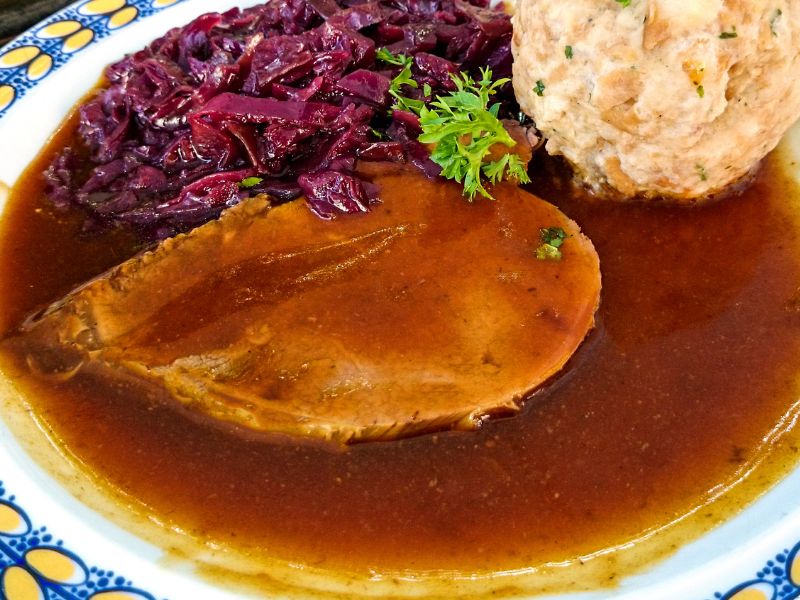
What To Eat and Drink in Stuttgart, Germany
From traditional Swabian dishes to modern German cuisine, there’s an array of flavors waiting to be savored. Here’s your travel guide to the must-try foods and beverages when visiting this vibrant city.
Traditional Swabian Delights
1. Maultaschen
- Description: Often referred to as Swabian ravioli, these are large dumplings filled with a mixture of minced meat, spinach, bread crumbs, and onions, seasoned with various herbs and spices.
- How to Enjoy: Maultaschen can be served in broth as a soup or fried with eggs and onions.
- Where to Find: Check out local restaurants like Weinstube Am Stadtgraben for a traditional take on this dish.
2. Spätzle
- Description: This is a type of soft egg noodle or dumpling that is a staple in Swabian cooking.
- How to Enjoy: Spätzle is often served as a side dish to meat dishes or topped with cheese (Käsespätzle) and crispy onions.
- Where to Find: Alte Kanzlei in Stuttgart offers some of the best homemade Spätzle in the city.
3. Schwäbischer Zwiebelrostbraten
- Description: A hearty beef dish featuring a thick steak topped with fried onions, often accompanied by gravy and Spätzle or potatoes.
- How to Enjoy: Ideal for a filling dinner, this dish pairs perfectly with a local red wine.
- Where to Find: Visit the Gasthaus Bären for a traditional rendition of this beloved local specialty.
Must-Try Meats and More
4. Sauerbraten
- Description: A pot roast, usually of beef (but other meats such as lamb, mutton, pork, and traditionally, horse), marinated before slow-cooking as pot roast.
- How to Enjoy: Sauerbraten is traditionally served with red cabbage, potato dumplings, or Spätzle.
- Where to Find: The cozy Weinstube Fröhlich offers a classic Sauerbraten that melts in your mouth.
5. Wurstsalat
- Description: A tart sausage salad made from Lyoner, vinegar, onions, and pickles, often dressed with a vinegar and oil dressing and served with bread.
- How to Enjoy: It’s a refreshing meal, perfect as a light dinner or a hearty lunch.
- Where to Find: Enjoy this dish at the Biergarten im Schlossgarten, where it’s served with a picturesque view.
Sweet Treats
6. Schwarzwälder Kirschtorte (Black Forest Cake)
- Description: Known worldwide, this iconic cake is made with several layers of chocolate sponge cake sandwiched with whipped cream and cherries.
- How to Enjoy: It’s a must-try for dessert or with an afternoon coffee.
- Where to Find: Café Königsbau is famed for its authentic and delicious Black Forest Cake.
7. Apfelkuchen (Apple Cake)
- Description: A popular German dessert, this cake is made from sliced apples, butter, flour, sugar, and eggs.
- How to Enjoy: Best served fresh from the oven and is a delightful accompaniment to coffee.
- Where to Find: Try it at Café Kaiserbau; their version is especially sumptuous.
Local Beverages
8. Württemberger Wine
- Description: The vineyards around Stuttgart produce some of Germany’s best wines, especially the red Trollinger and white Riesling.
- How to Enjoy: Visit a local Weinstube or partake in a wine tasting tour in the region.
- Where to Find: The Weinbaumuseum Stuttgart offers tastings and insights into the local wine culture.
9. German Beer
- Description: No visit to Germany is complete without sampling some of the local brews.
- How to Enjoy: Enjoy a refreshing pilsner or explore local specialties at a beer garden.
- Where to Find: Calwer-Eck-Bräu, a local brewery in Stuttgart, offers a great selection along with traditional German pub food.
Culinary Experiences
10. Stuttgart Beer Festival (Cannstatter Volksfest)
- Description: While not a dish, this festival is an essential experience for foodies, featuring countless food stalls and beer tents.
- How to Enjoy: Sample various dishes and brews in one of Europe’s largest and most exciting beer festivals.
- Where to Find: Held in the Cannstatter Wasen area, this annual event draws visitors from all over the world.
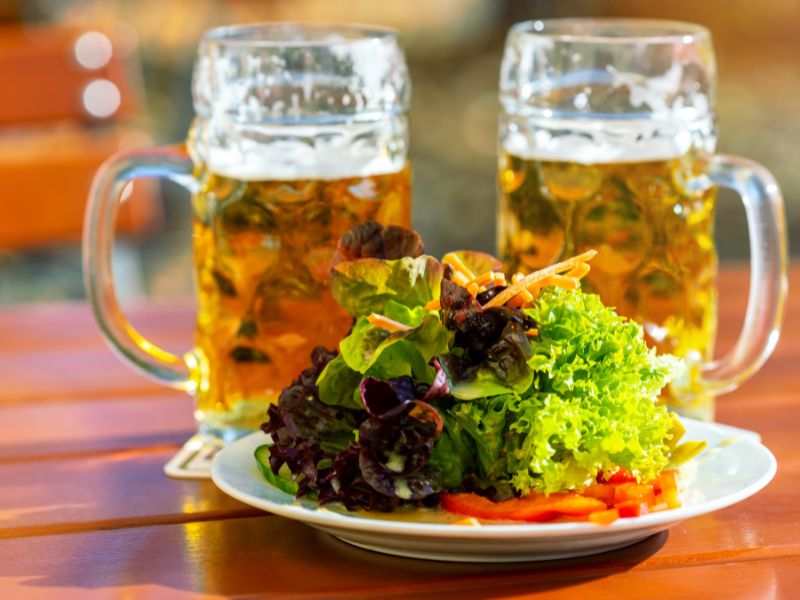
Top Restaurants in Stuttgart, Germany
Whether you’re looking for a fine dining experience or a cozy local eatery, here are some of the top restaurants in Stuttgart that promise an unforgettable meal.
1. Restaurant Christophorus
- Cuisine: Steakhouse
- Specialty: Known for serving some of the best steaks in town, sourced from premium cuts of beef.
- Ambience: Located in the Porsche Museum, the restaurant offers a sleek, modern setting with views of classic Porsche cars.
- Why Visit: Perfect for car enthusiasts and meat lovers alike, combining a unique setting with top-notch dining.
2. Wielandshöhe
- Cuisine: Swabian, German
- Specialty: Offers a seasonal menu with ingredients sourced from local producers, including dishes like Maultaschen and Zwiebelrostbraten.
- Ambience: A warm, inviting atmosphere with panoramic views of Stuttgart’s vineyards.
- Why Visit: Celebrity chef Vincent Klink heads this establishment, ensuring a high-quality culinary experience that highlights regional traditions.
3. Speisemeisterei
- Cuisine: Contemporary European
- Specialty: Known for its innovative approach to traditional dishes, the restaurant has a Michelin star for its exquisite menu.
- Ambience: Set in a historic building in the Hohenheim Gardens, offering a romantic and refined dining experience.
- Why Visit: Ideal for special occasions, the Speisemeisterei offers beautifully presented dishes and a selection of fine wines.
4. YoSH
- Cuisine: Fusion, International
- Specialty: Focuses on a fusion of European and Asian cuisines, with standout dishes such as sushi and Wagyu beef.
- Ambience: Modern and minimalist decor, providing a chic backdrop for dining.
- Why Visit: For a taste of high-end fusion cuisine that creatively blends different culinary traditions.
5. Weinstube Am Stadtgraben
- Cuisine: Traditional German, Swabian
- Specialty: Offers classic Swabian dishes like Schnitzel and Spätzle, prepared with a touch of gourmet flair.
- Ambience: A cozy, traditional German wine tavern setting, complete with rustic wooden furniture and a friendly atmosphere.
- Why Visit: Experience authentic local cuisine in a setting that feels like stepping back in time.
6. Cube
- Cuisine: Modern European
- Specialty: Known for its avant-garde culinary techniques and presentation, including a popular tasting menu.
- Ambience: Located atop Stuttgart’s art museum, the restaurant offers striking views over the city’s rooftops.
- Why Visit: A great choice for foodies looking for a modern dining experience with spectacular views.
7. OGGI – Pizza Bar
- Cuisine: Italian
- Specialty: Excelling in handmade pizzas and traditional Italian pastas.
- Ambience: Lively and casual, perfect for a relaxed meal with friends or family.
- Why Visit: For a slice of the best pizza in town, OGGI’s vibrant atmosphere and authentic dishes are not to be missed.
8. Gasthaus Bären
- Cuisine: German, Swabian
- Specialty: Traditional dishes served with a contemporary twist; the roast duck is a local favorite.
- Ambience: Offers a quaint, homely feel typical of a traditional German Gasthaus.
- Why Visit: For a hearty, traditional meal that showcases the best of local cuisine in a warm and welcoming setting.
9. Der Rote Hirsch
- Cuisine: German, International
- Specialty: Known for its creatively plated modern dishes and a wide selection of vegan options.
- Ambience: Contemporary with artistic touches that reflect the menu’s creative approach.
- Why Visit: Perfect for diners looking to enjoy innovative cooking in a trendy, modern environment.
10. Zirbelstube
- Cuisine: German, Fine Dining
- Specialty: Offers a luxury dining experience with meticulously crafted dishes that change seasonally.
- Ambience: Elegant and sophisticated, suitable for a refined dining experience.
- Why Visit: If you’re in search of a Michelin-starred meal that combines luxury with innovation, Zirbelstube is a must.
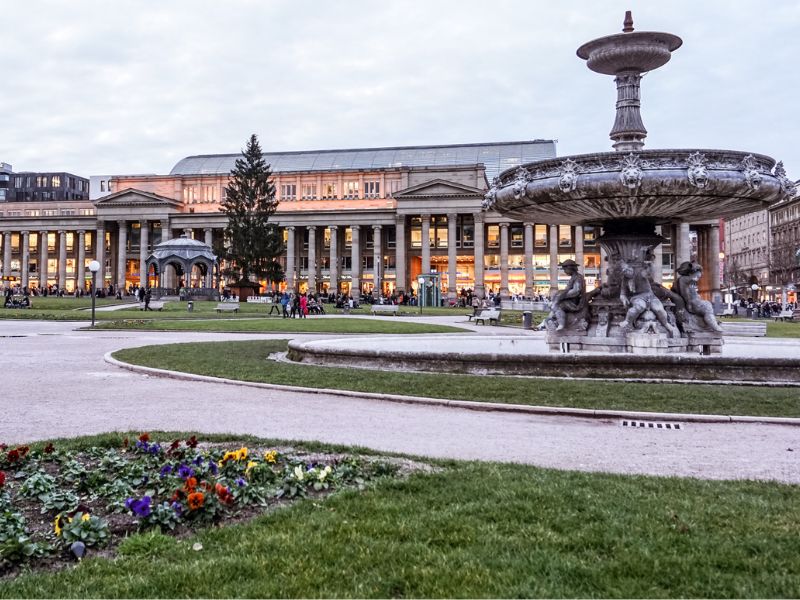
Tours For Visitors To Stuttgart, Germany
Here’s a comprehensive guide to some of the best tours available in Stuttgart.
1. Mercedes-Benz Museum Tour
- Overview: A must-visit for car enthusiasts, this tour offers an in-depth look at the history of one of the world’s most iconic car brands.
- Features: The tour covers everything from the earliest vehicles to the latest innovations, displayed over several floors.
- Duration: Approximately 1.5 to 2 hours.
- Why Go: To see a vast collection of more than 160 vehicles, including legendary racing cars and futuristic concepts.
2. Porsche Museum Tour
- Overview: Another essential stop for automotive fans, this tour highlights the history and engineering excellence of Porsche.
- Features: Explore over 80 vehicles and numerous small exhibits detailing Porsche’s contribution to automotive history.
- Duration: Around 1 to 2 hours.
- Why Go: To gain insights into the design and performance philosophy of Porsche, with the opportunity to see rare models up close.
3. Stuttgart City Walking Tour
- Overview: Discover the heart of Stuttgart by foot on a guided walking tour around its central districts.
- Features: Includes visits to key sights such as Schlossplatz, the Stuttgart Market Hall, and the Stiftskirche.
- Duration: Usually about 2 hours.
- Why Go: Perfect for first-time visitors to get their bearings and learn about the city’s history from knowledgeable local guides.
4. Wine Walking Tour in the Vineyards
- Overview: Stuttgart is surrounded by beautiful vineyards, and this tour offers a scenic and tasty exploration of local wine culture.
- Features: The tour includes a walk through picturesque vineyards, wine tastings, and insights into local viticulture.
- Duration: About 3 to 4 hours.
- Why Go: To experience the stunning landscapes of the Neckar Valley and enjoy some of the best local wines.
5. Neckar River Boat Tour
- Overview: See Stuttgart from a different perspective with a leisurely boat tour along the Neckar River.
- Features: Offers views of the city’s waterfront landmarks and scenic natural areas around the river.
- Duration: Varies, with options from short one-hour trips to half-day excursions.
- Why Go: A relaxing way to see the city, perfect for families and couples looking for a serene outing.
6. Stuttgart Beer Tour
- Overview: Dive into the local beer scene with a guided tour that visits several breweries and pubs in the city.
- Features: Sample various German beers, learn about the brewing process, and enjoy some traditional German snacks.
- Duration: About 3 to 4 hours.
- Why Go: To taste some of the best local brews and learn about Stuttgart’s brewing traditions.
7. Stuttgart by Segway Tour
- Overview: Zip around Stuttgart’s attractions on a fun and fast-paced Segway tour.
- Features: Includes training on how to use the Segway and stops at major city landmarks.
- Duration: Typically 2 to 3 hours.
- Why Go: For a unique and exhilarating way to explore the city’s sights without tiring your feet.
8. Architectural Tour of Stuttgart
- Overview: This tour focuses on Stuttgart’s renowned architectural landmarks, including both historic and modern structures.
- Features: Visit the Weissenhof Estate, the New and Old Castles, and other significant buildings.
- Duration: About 3 hours.
- Why Go: To appreciate Stuttgart’s diverse architectural styles and understand the city’s development through its buildings.
9. Black Forest Day Trip
- Overview: Venture out of the city for a day to explore the enchanting Black Forest, just a short drive from Stuttgart.
- Features: The tour typically includes visits to quaint villages, scenic spots, and traditional cuckoo clock makers.
- Duration: Full day.
- Why Go: To experience the mythical beauty of the Black Forest and enjoy its peaceful, natural setting.
10. Historical and Cultural Tour of Ludwigsburg Palace
- Overview: Just outside Stuttgart, this tour explores the magnificent Ludwigsburg Palace, one of the largest Baroque buildings in Europe.
- Features: Guided tour of the palace and its gardens, with insights into the lives of the dukes who lived there.
- Duration: Half-day.
- Why Go: To step back in time and experience the opulence and history of this grand ducal residence.
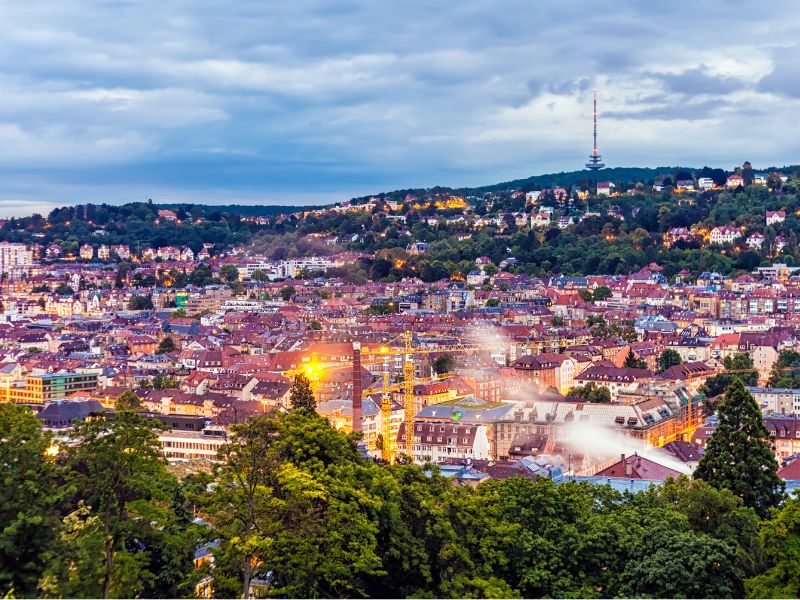
Stuttgart Accommodations Guide: Hotels, Guesthouses and Hostels
From luxury hotels to cozy guesthouses and budget-friendly hostels, here’s a quick travel guide to some of the best places to stay in Stuttgart.
Luxury Hotels
1. Althoff Hotel am Schlossgarten
- Location: Centrally located near the city’s main train station and the lush Schlossgarten Park.
- Features: Offers elegant rooms with views of the park or the city, fine dining options, and a wine bar.
- Ideal for: Those looking for a luxurious stay with easy access to Stuttgart’s cultural sites.
- Unique Perk: Gourmet cuisine at the Michelin-starred restaurant, Zirbelstube.
2. Le Méridien Stuttgart
- Location: Across from Schlossgarten Park, close to the State Gallery and opera house.
- Features: Features spacious, modern rooms, a wellness area with a pool, and several dining options.
- Ideal for: Culture enthusiasts and business travelers looking for comfort and convenience.
- Unique Perk: Direct connection to the cultural heart of Stuttgart via the hotel’s Unlock Art™ program, which offers complimentary access to local museums.
Mid-Range Hotels
3. Park Inn by Radisson Stuttgart
- Location: Near Marienplatz in a lively district with good public transport links.
- Features: Comfortable and contemporary rooms with all standard amenities, a rooftop restaurant, and a fitness center.
- Ideal for: Business travelers and tourists looking for value and quality.
- Unique Perk: Rooftop terrace that offers stunning views of the city.
4. Hotel Unger
- Location: Just a five-minute walk from Stuttgart’s central station and close to shopping areas.
- Features: Offers bright, airy rooms and a substantial breakfast buffet.
- Ideal for: Travelers who appreciate proximity to both shopping and transport.
- Unique Perk: A vast breakfast selection that is well regarded among guests.
Budget Accommodations
5. Hostel Alex 30
- Location: Situated in the heart of Stuttgart, offering easy access to all main attractions.
- Features: Clean, basic rooms and dormitories with private or shared bathrooms, a communal kitchen, and a lounge area.
- Ideal for: Backpackers and young travelers looking for a social environment and affordable rates.
- Unique Perk: Themed nights and communal activities that help guests mingle and explore the city together.
6. Jugendherberge Stuttgart International
- Location: Nestled between Stuttgart’s cultural and green belt areas.
- Features: Modern hostel with a range of room types, from dorms to family units, plus a buffet breakfast included.
- Ideal for: Families and young travelers, especially those on a tight budget.
- Unique Perk: Offers a stunning view of the Neckar Valley.
Guesthouses and B&Bs
7. Gasthof Traube
- Location: In the Bad Cannstatt district, known for its traditional festivals and thermal baths.
- Features: Traditional Swabian guesthouse with rustic, cozy rooms and an onsite restaurant serving regional specialties.
- Ideal for: Travelers looking to experience traditional German hospitality and food.
- Unique Perk: Located close to the Cannstatter Wasen, home to the famous Volksfest.
8. Pension am Heusteig
- Location: Quietly located in the Heusteigviertel, a charming neighborhood known for its beautiful buildings and proximity to the city center.
- Features: Comfortable, simple rooms in a picturesque setting, with a generous breakfast included.
- Ideal for: Couples and solo travelers seeking a peaceful retreat near the bustling city center.
- Unique Perk: Its garden terrace, where guests can relax after a day of sightseeing.
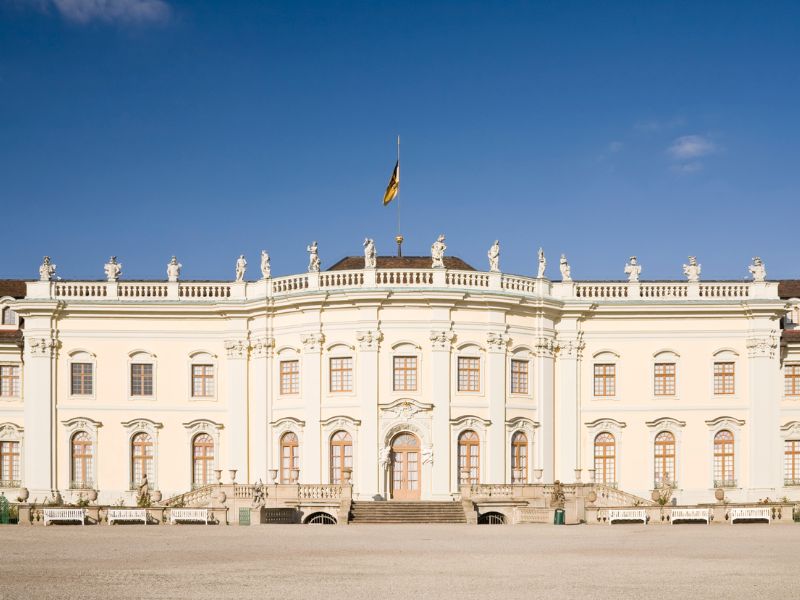
Day Trips From Stuttgart, Germany
Here are ten great day trip ideas, each offering unique experiences for travelers looking to expand their horizons beyond the city limits.
1. Heidelberg
- Description: Just an hour away, Heidelberg is famous for its romantic cityscape, including the iconic Heidelberg Castle and the picturesque Old Bridge.
- Activities: Tour the ruins of Heidelberg Castle, stroll along the Neckar River, and explore the baroque old town.
- Best Time to Visit: Spring and fall offer mild weather, perfect for walking tours and outdoor cafes.
- Tips: Don’t miss the Philosophenweg (Philosophers’ Walk) for the best views of the city and castle.
2. Ludwigsburg
- Description: Known as the “Versailles of Swabia,” Ludwigsburg is just 20 minutes north of Stuttgart and boasts one of Europe’s largest Baroque palaces.
- Activities: Visit Ludwigsburg Palace and its impressive gardens, explore the Fairy Tale Garden, and check out the Baroque Christmas Market in December.
- Best Time to Visit: Autumn, when the Ludwigsburg Pumpkin Festival transforms the palace gardens into a colorful outdoor exhibition.
- Tips: Take a palace tour to fully appreciate the rich history and art of the palace’s interior and state rooms.
3. Black Forest
- Description: The mythical Black Forest is about an hour and a half drive from Stuttgart and offers lush forests, traditional villages, and culinary specialties.
- Activities: Hike some of the Black Forest trails, visit the cuckoo clock shops in Triberg, and try the famous Black Forest cake.
- Best Time to Visit: Summer for hiking and winter for a snowy wonderland.
- Tips: Stop by the open-air museum Vogtsbauernhof to see original Black Forest farmhouses and learn about local history.
4. Lake Constance (Bodensee)
- Description: Bordering Germany, Austria, and Switzerland, Lake Constance is less than two hours from Stuttgart and is one of Europe’s largest lakes.
- Activities: Take a boat tour of the lake, visit Mainau Island (known as Flower Island for its beautiful gardens), and explore the medieval city of Konstanz.
- Best Time to Visit: Late spring to early fall for boat rides and garden tours.
- Tips: Be sure to visit the Zeppelin Museum in Friedrichshafen to learn about the airship’s history.
5. Strasbourg, France
- Description: Just over the border in France, Strasbourg is an enticing blend of French and German cultures, famous for its gothic cathedral and charming timber-framed houses.
- Activities: Tour the Strasbourg Cathedral, enjoy a boat ride along the Ill River, and wander through the Petite France district.
- Best Time to Visit: December for the magical Christmas markets.
- Tips: Try the local Alsace wines and the traditional dish, tarte flambée.
6. Tübingen
- Description: A quintessential university town, Tübingen is steeped in history and bursting with youthful energy.
- Activities: Punt on the Neckar River, stroll the ancient cobblestone streets of the Altstadt, and climb the Hölderlinturm for views of the town.
- Best Time to Visit: Anytime, but autumn is particularly beautiful as the leaves change color along the river.
- Tips: Visit on a Saturday to enjoy the vibrant local market in the town square.
7. Rothenburg ob der Tauber
- Description: Rothenburg is one of the best-preserved medieval towns in Germany, looking much like it did in the 1600s.
- Activities: Walk the town walls, visit the Medieval Crime and Justice Museum, and explore the German Christmas Museum if you’re there during the holidays.
- Best Time to Visit: Early summer or late fall to avoid the peak tourist season.
- Tips: The Night Watchman’s Tour is a must-do for a unique and entertaining overview of the town’s history.
8. Schwäbisch Hall
- Description: This historic town is known for its beautifully preserved architecture and vibrant cultural scene.
- Activities: Visit St. Michael’s Church, stroll along the Kocher River, and explore the local art galleries and museums.
- Best Time to Visit: Summer for outdoor concerts and theater performances at the open-air steps of St. Michael.
- Tips: Don’t miss the Salt Museum, which details the town’s development through its salt production.
9. Baden-Baden
- Description: Nestled in the Black Forest, Baden-Baden is famed for its luxurious spa resorts and the opulent Casino Baden-Baden.
- Activities: Relax in the thermal baths, take a walk through the Lichtentaler Allee, and try your luck at the casino.
- Best Time to Visit: Winter for a spa escape or summer for hiking and enjoying the lush park landscapes.
- Tips: Pack a formal outfit if you plan to visit the casino, as there is a dress code.
10. Nuremberg
- Description: Rich in history, Nuremberg is well known for its medieval architecture, including the imposing Nuremberg Castle and the old city walls.
- Activities: Visit the Nuremberg Trials Memorial, explore the Germanisches Nationalmuseum, and taste the famous Nuremberg sausages.
- Best Time to Visit: December to experience one of Germany’s oldest Christmas markets.
- Tips: Try the local gingerbread, which is particularly popular during the Christmas season.
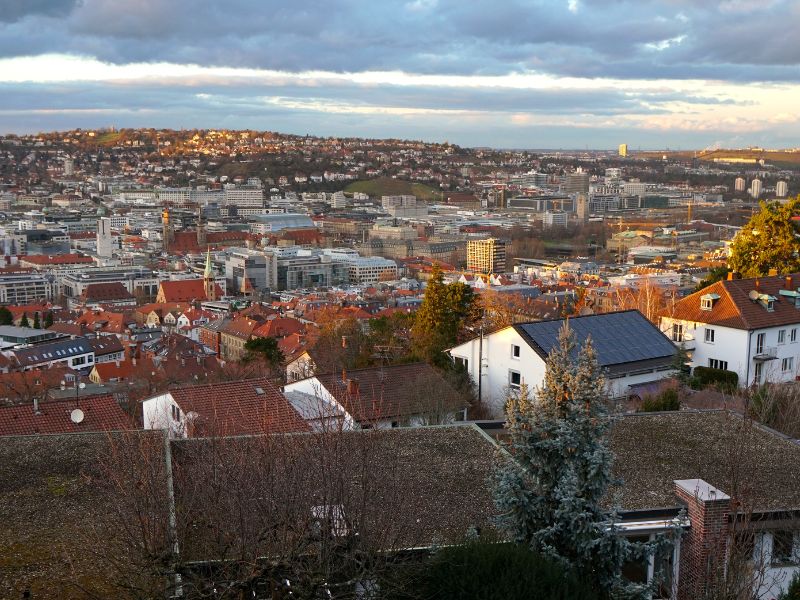
Stuttgart Transportation Guide
Whether you’re commuting within the city or planning excursions to nearby attractions, here’s a brief travel guide to getting around Stuttgart efficiently.
Public Transport System
1. S-Bahn (Suburban Train)
- Overview: The S-Bahn is a quick and efficient way to travel across the city and to neighboring regions. It operates within the Verkehrs- und Tarifverbund Stuttgart (VVS) system, which covers the entire metropolitan area.
- Routes: There are several S-Bahn lines connecting Stuttgart with suburbs and nearby towns like Ludwigsburg, Esslingen, and Böblingen.
- Frequency: Trains run every 10 to 20 minutes depending on the time of day.
- Tips: Check the VVS website or app for real-time schedules and platform changes.
2. U-Bahn (Stuttgart Stadtbahn)
- Overview: The Stadtbahn, Stuttgart’s tram system, serves the city center and extends to many suburbs. It’s especially useful for getting around central areas and reaching tourist attractions.
- Routes: Multiple lines crisscross the city, with stops at major landmarks and connections to bus and S-Bahn services.
- Frequency: Trams run every 8 to 10 minutes during peak hours.
- Tips: Tickets must be validated on platforms before boarding. Failure to do so can result in fines.
Buses
3. City Buses
- Overview: Stuttgart’s extensive bus network fills in the gaps between S-Bahn and Stadtbahn routes, reaching areas less accessible by rail.
- Routes: Numerous lines, including night buses (Nachtbus) that operate after other public transport has stopped for the night.
- Frequency: Varies widely by route; central routes have buses running every 10-15 minutes, less frequent in outer areas.
- Tips: Night buses are a safe and reliable way to return home after an evening out, especially from the city center.
Other Transportation Options
4. Taxis
- Overview: Taxis are readily available throughout Stuttgart and can be hailed on the street, found at taxi stands, or booked via phone or app.
- Cost: Starting fare is usually around 3-4 euros, with additional charges per kilometer. Fares increase slightly at night and on weekends.
- Tips: Taxis are a convenient option for direct travel, especially if you are traveling with luggage or in a group.
5. Car Rentals
- Overview: Numerous car rental agencies operate in Stuttgart, including major international brands and local companies.
- Where to Rent: Available at the airport, main train station, and various locations throughout the city.
- Tips: Consider a rental if planning to explore rural areas of Baden-Württemberg or if public transport does not suit your schedule.
6. Bicycles
- Overview: Stuttgart supports cycling with designated bike lanes and routes. Bike rental services are available, including sharing schemes.
- Renting Bikes: Services like Call a Bike (Deutsche Bahn) and local rental shops offer hourly, daily, and weekly rentals.
- Tips: Cycling is an ideal way to enjoy Stuttgart’s parks and green spaces, though be prepared for hilly sections in some parts of the city.
7. Walking
- Overview: Stuttgart’s city center is compact and pedestrian-friendly, making walking a pleasant and practical option for exploring areas like Schlossplatz and Königstraße.
- Advantages: Walking provides a more intimate view of Stuttgart’s charming architecture and vibrant street life.
- Tips: Comfortable walking shoes are a must, as cobblestone streets can be unforgiving.
Travel Tips
- Travel Passes: The StuttgartCard offers unlimited travel within the city’s public transportation system plus discounts on many tourist attractions.
- Accessibility: Most public transport options are accessible for passengers with mobility issues, including low-floor trams and buses with ramps.
- Navigation: Apps like Google Maps and the VVS Mobile app are helpful for route planning and timetable information.
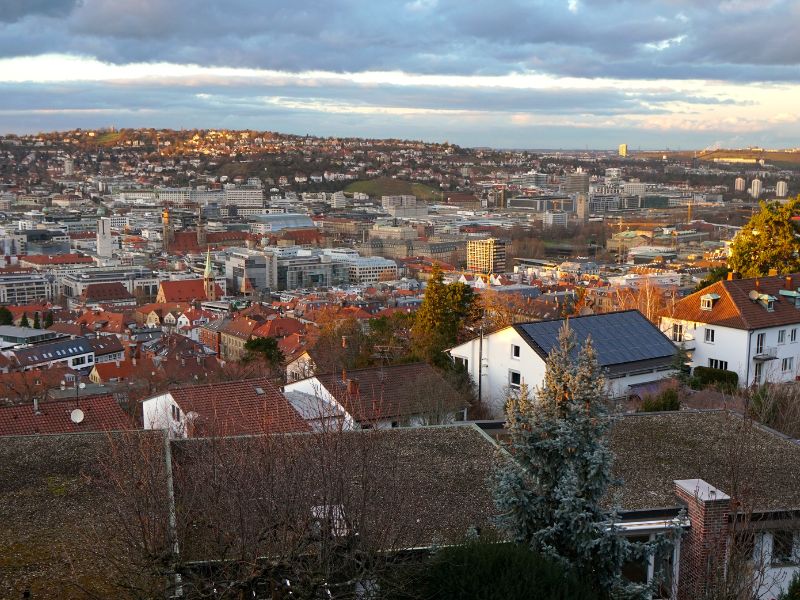
Stuttgart 3-4 Days Travel Itinerary
Here’s a detailed itinerary for 3 to 4 days that covers the best of Stuttgart and offers a taste of what this dynamic city has to offer.
Day 1: Discovering Stuttgart’s Heart
Morning: Start at Schlossplatz
- Activities: Begin your day in Stuttgart’s largest square, Schlossplatz. It’s a perfect spot for photos with the New Palace as a backdrop and is a bustling hub of activity.
- Tips: Grab a coffee and a snack from a nearby café and enjoy some people-watching in this lively area.
Afternoon: Explore Stuttgart’s Museums
- Mercedes-Benz Museum: Dive into more than 130 years of automotive history displayed in a futuristic building.
- Porsche Museum: Continue your automotive journey at the Porsche Museum, showcasing over 80 vehicles and many small exhibits.
- Tips: Allocate about 2 hours for each museum to fully appreciate their exhibits.
Evening: Dinner in the City
- Suggestions: Head back to the city center and try local Swabian dishes at a traditional restaurant such as Weinstube Am Stadtgraben.
Day 2: Art and Culture
Morning: Art and Historical Museums
- Kunstmuseum Stuttgart (Art Museum): Start your day with contemporary and modern art in a cube-shaped glass building.
- Linden Museum: Visit this ethnological museum to see non-European art and cultural artifacts.
- Tips: Check for any special exhibitions at the Kunstmuseum, which are often highlights.
Afternoon: Wilhelma Zoo and Botanical Gardens
- Activities: Spend your afternoon at Wilhelma, one of Europe’s largest zoos, which also doubles as a botanical garden.
- Tips: Don’t miss the Moorish architecture and the magnolia grove if visiting in spring.
Evening: Enjoy Stuttgart’s Nightlife
- Suggestions: Explore the bars and pubs in the Hans-im-Glück quarter, known for its vibrant evening scene and fairy-tale themed decor.
Day 3: Day Trip to Ludwigsburg
All Day: Explore Ludwigsburg
- Morning: Take a 20-minute train ride to Ludwigsburg and visit the magnificent Ludwigsburg Palace.
- Afternoon: Stroll through the palace gardens and visit the Fairy Tale Garden if traveling with children.
- Evening: Return to Stuttgart and enjoy a meal at a restaurant in the city center.
- Tips: Check the palace’s event schedule; they often host concerts, festivals, and themed tours that could be a highlight of your visit.
Day 4: Leisure and Local Culture (Optional Day)
Morning: Relax in Killesberg Park
- Activities: Take a leisurely morning walk through Killesberg Park, known for its lovely landscaping and panoramic tower views.
- Tips: Enjoy a ride on the park’s miniature railway, especially fun for families.
Afternoon: Shopping and Strolling
- Königstraße: Spend your afternoon shopping along Königstraße, Stuttgart’s main shopping street, or explore the Gerber mall for more retail therapy.
- Local Markets: Visit Markthalle if you appreciate gourmet food and local produce in an Art Nouveau setting.
Evening: Stuttgart State Theatre
- Activities: End your trip with a performance at the Stuttgart State Theatre, which offers opera, ballet, and theatre productions.
- Tips: Book tickets in advance to secure good seats and check the schedule for English subtitled performances if necessary.
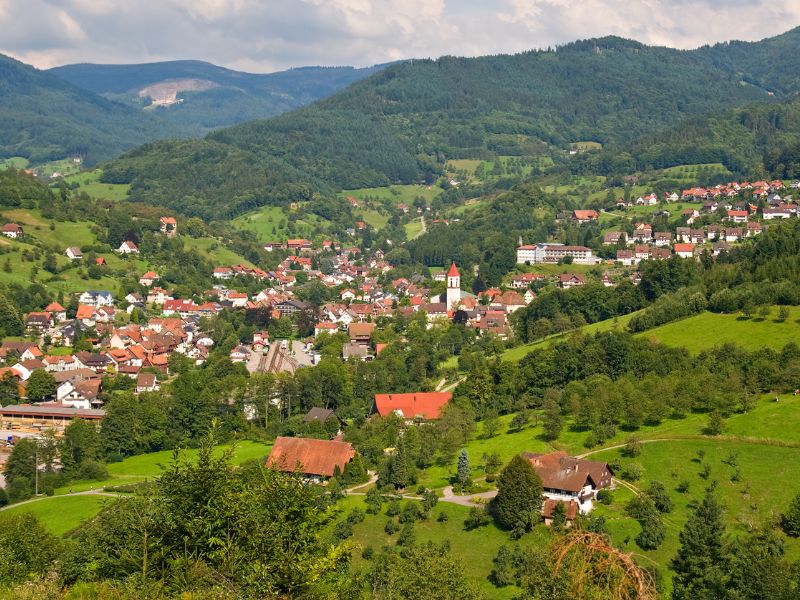
Where To Visit After Your Trip To Stuttgart?’
here’s a list of top places to visit after Stuttgart, each offering unique experiences.
1. Munich
- Description: Bavaria’s capital is renowned for its beautiful architecture, the world-famous Oktoberfest, and its vibrant arts scene.
- Activities: Explore the Marienplatz, visit the BMW Museum, and spend an afternoon in the vast English Garden.
- Best Time to Visit: Late September to early October to experience Oktoberfest.
- Tips: Don’t miss the Deutsches Museum, one of the oldest and largest science and technology museums in the world.
2. Frankfurt
- Description: Known as the financial capital of Germany, Frankfurt is a high-powered business hub with a dynamic cultural and historical side.
- Activities: Stroll along the River Main, visit the Städel Museum to see Europe’s art history, and explore the Römerberg, Frankfurt’s old central square.
- Best Time to Visit: Early December to enjoy the magical Christmas markets.
- Tips: Try the local apple wine in one of the traditional Sachsenhausen pubs.
3. The Black Forest
- Description: The Black Forest is a vast forested region known for its picturesque villages and traditional cuckoo clocks.
- Activities: Hike in the scenic trails, relax in thermal spas of Baden-Baden, and visit the open-air museum Vogtsbauernhof to learn about local history.
- Best Time to Visit: May or June for the best hiking weather and fewer crowds.
- Tips: Drive the Schwarzwald Hochstrasse, a high road that offers breathtaking views and leads to many attractions.
4. Heidelberg
- Description: This charming city is famous for its prestigious university and the romantic ruins of Heidelberg Castle.
- Activities: Tour the castle, walk the old bridge, and take a philosophical stroll on the Philosophenweg for stunning views of the city.
- Best Time to Visit: Fall for the beautiful autumn colors in the city’s many parks.
- Tips: Enjoy a guided tour of the old university and its student prison.
5. Lake Constance
- Description: Bordering Germany, Austria, and Switzerland, Lake Constance is perfect for water sports, cycling, and exploring small lakeside towns.
- Activities: Visit Mainau Island botanical gardens, explore the Zeppelin Museum in Friedrichshafen, and take a boat tour around the lake.
- Best Time to Visit: Summer for outdoor activities and vibrant local festivals.
- Tips: Take a day trip to the Rhine Falls in Switzerland, Europe’s largest waterfall, nearby.
6. Nuremberg
- Description: Steeped in history, Nuremberg is known for its medieval architecture, including the impressive Nuremberg Castle and the historic old town.
- Activities: Explore the Germanisches Nationalmuseum, visit the Nazi party rally grounds, and try the famous Nuremberg sausages.
- Best Time to Visit: December to experience one of Germany’s oldest Christmas markets.
- Tips: Check out the medieval dungeons under the old city hall for a chilling glimpse into the past.
7. Strasbourg, France
- Description: Just across the border in France, Strasbourg offers a blend of French and German cultures with its stunning Gothic cathedral and picturesque timber-framed houses.
- Activities: Tour the cathedral, enjoy a boat ride along the Ill River, and explore the European Parliament.
- Best Time to Visit: Christmas for the renowned Strasbourg Christmas Market.
- Tips: Try the local Alsace wines and the traditional tarte flambée.
8. Zurich, Switzerland
- Description: A short train ride away, Zurich is known for its well-preserved medieval old town and vibrant cultural life.
- Activities: Visit the Kunsthaus, one of Switzerland’s most important art museums, enjoy shopping on Bahnhofstrasse, and explore the Old Town.
- Best Time to Visit: Summer for pleasant weather and numerous outdoor festivals.
- Tips: Take a boat ride on Lake Zurich to enjoy the city from a different perspective.
9. Baden-Baden
- Description: Nestled in the Black Forest, Baden-Baden is famous for its luxurious spa resorts and the opulent Casino Baden-Baden.
- Activities: Relax in the thermal baths, take a stroll through the Lichtentaler Allee, and try your luck at the casino.
- Best Time to Visit: Winter for a cozy spa experience or summer for hiking in the forest.
- Tips: Attend a performance at the Festspielhaus, one of Europe’s largest opera houses.
10. Salzburg, Austria
- Description: Known for its baroque architecture and as the birthplace of Mozart, Salzburg is a cultural gem just across the Austrian border.
- Activities: Tour the Hohensalzburg Fortress, visit Mozart’s birthplace, and explore the Mirabell Gardens.
- Best Time to Visit: Summer for the Salzburg Festival, a world-class music and drama festival.
- Tips: Indulge in a Sachertorte at one of the local cafés for a taste of Austrian sweetness.
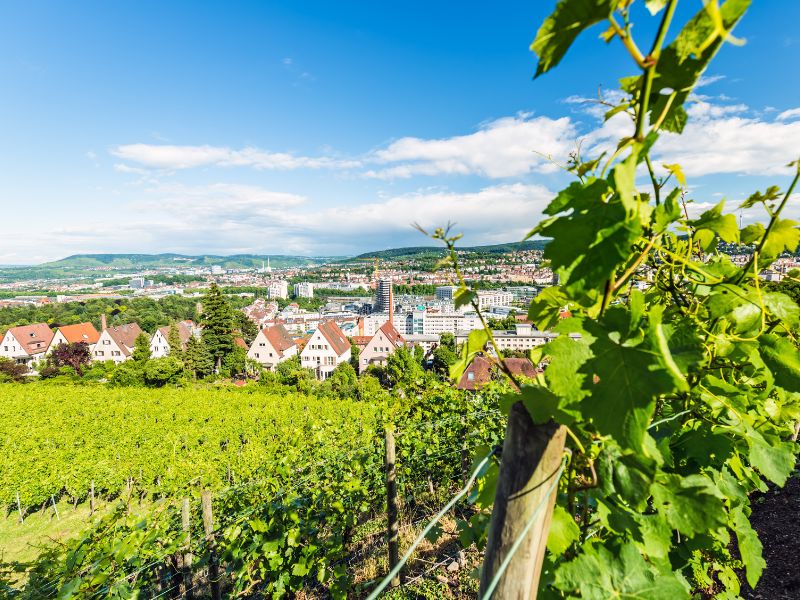
Essential Stuttgart Travel Questions Answered: First-Timer Tips, Local-Style Planning Advice & Smart Ways to See Germany’s Car-Capital City
How many days do you really need in Stuttgart?
It depends. If you’re here mainly for the two car museums and a quick taste of the center, two full days is enough. You can do Mercedes-Benz Museum one day, Porsche Museum the next, and still squeeze in Schlossplatz, a wine tavern dinner, and a skyline view.
For a more balanced trip, I’d aim for three days. That gives you time for the art scene, the palaces, parks like Killesberg, and at least one slower neighborhood wander. Four days is ideal if you want a day trip to Ludwigsburg, Tübingen, or even a Black Forest sampler without feeling like you’re speedrunning your vacation.
Is Stuttgart worth visiting if I’m not a car person?
Absolutely. The city’s automotive identity is real, but it isn’t the whole story. Stuttgart has a surprisingly strong arts and architecture lineup (hello, Staatsgalerie and the modernist Weissenhof Estate), plus a very livable green-city vibe with parks threaded through the center.
Even if you just pick one car museum for cultural context, you’ll still have plenty of non-engine joy: palace squares, vineyards, local food, and a great base for exploring this part of Baden-Württemberg.
What’s the best time of year to visit Stuttgart?
Yes. I’m cheating, but for good reason: Stuttgart has distinct seasonal personalities.
Late spring and early autumn are the easiest wins for weather and city life. Summer is great for parks, beer gardens, and outdoor events. If you love big festive energy, the fall is prime time thanks to the Cannstatter Volksfest. Winter is cozier and more atmospheric, especially if you plan your visit around the Christmas market.
Where should I stay in Stuttgart for a first trip?
For convenience, staying near the city center makes life easy. You’ll be close to Schlossplatz, Königstraße, transit connections, and a lot of the classic sightseeing.
If you want a slightly more local feel, neighborhoods like Heusteigviertel or areas around Marienplatz can be a nice compromise between charm and access. Car-museum-focused travelers sometimes choose to stay closer to Bad Cannstatt or near Porsche’s side of town, but for most first-timers, a central base saves time and keeps the trip simple.
Is the StuttgartCard actually worth it?
It depends. If you’re planning to hit multiple paid attractions in a short window and use public transport a lot, the StuttgartCard can be a smart buy. It’s designed to bundle transit with discounts or entry at major sights like museums and landmarks.
If your plan is mostly parks, neighborhoods, and one big museum, you might not break even. The quick way to decide is to list your must-dos, then compare that rough total to the card price for the duration you’re considering.
What’s the easiest way to get around Stuttgart without a car?
Absolutely. Public transport is your best friend here. The S-Bahn and U-Bahn/Stadtbahn network covers central sights and makes it straightforward to reach areas like Bad Cannstatt, the TV tower zone, and connections for day trips.
Walking also works well in the core, though Stuttgart’s valley setting means you’ll feel some hills once you wander beyond the flattest central areas. If you’re planning to explore vineyards or outskirts on your own schedule, you can mix transit with short taxi rides.
Should I rent a car for Stuttgart and the surrounding region?
Not really for the city itself. Driving and parking can be more hassle than it’s worth if your plan is mostly museums, squares, and central neighborhoods.
A rental becomes useful if you want flexibility for multiple regional stops in a short time—like a Black Forest loop, smaller wine villages, or a Lake Constance-style extension. If you’re only doing one classic day trip, the trains usually win on simplicity.
What are the best day trips from Stuttgart?
Yes—this is one of Stuttgart’s secret superpowers. Ludwigsburg is the easiest slam-dunk for palace grandeur and gardens. Tübingen offers a charming university-town vibe with pretty river scenery.
Heidelberg is a longer but popular classic, and the Black Forest can be done as a long day if you focus on one area rather than trying to “see it all.” If you’re the kind of traveler who likes to collect small, high-quality day adventures, Stuttgart is a very comfortable base.
What are the absolute top “don’t miss” sights if I only have one day?
It depends on your interests, but here’s a realistic one-day shape. Prioritize one big anchor museum—Mercedes-Benz is the broader historical sweep, while Porsche leans into sleek design and performance.
Then pair it with a center stroll around Schlossplatz and a short taste of local food. If the weather’s good, add a park stop like Killesberg or a viewpoint. One day will feel fast, but you can still get a satisfying snapshot.
What local food should I try in Stuttgart and where should I look for it?
Absolutely. This is prime Swabian comfort-food territory. Look for Maultaschen, Spätzle (especially Käsespätzle), and Zwiebelrostbraten.
A great way to experience them is in a traditional Weinstube. The vibe is usually cozy, unfussy, and perfect for winding down after a museum-heavy day. Pair your meal with a local Württemberg wine and you’ll understand why Stuttgart quietly wins hearts through the stomach.
How expensive is Stuttgart for travelers?
It depends. Compared with some of Germany’s most tourist-saturated cities, Stuttgart can feel moderately priced, but it isn’t a bargain destination either.
You can keep costs reasonable with public transport, casual Swabian restaurants, and a focus on parks and free city wandering. The two big car museums and major cultural attractions will be your main ticket expenses. If you’re trying to travel mid-range, you can usually make a comfortable daily budget work without going full austerity.
Is Stuttgart safe for tourists?
Yes. Stuttgart is generally a safe, relaxed city for travelers. Standard city common sense applies: watch your belongings in crowded areas, especially during big events and markets.
Late-night transit feels orderly, and the city doesn’t have a reputation for aggressive tourist scams. If anything, your biggest risk is overloading your schedule and realizing too late that you needed an extra day.
Is Stuttgart a good destination for families with kids?
Absolutely. Wilhelma Zoo and Botanical Garden is a strong family anchor, and parks like Killesberg add playgrounds, open space, and easy “let the kids run” energy.
The museums can work well too if you balance them with outdoor breaks. If you’re traveling with younger kids, planning shorter sightseeing bursts with one major highlight per day keeps everyone happier.
How accessible is Stuttgart for travelers with mobility concerns?
It depends. Many major sites and the public transport system are modern and increasingly accessible, but Stuttgart’s geography can be a factor. The city sits in a basin with hills around it, so some neighborhoods and viewpoints involve slopes.
If mobility is a key concern, choose a central base close to transit lines, favor elevators and step-free routes where available, and consider taxis for hillier hops. You can still have a great trip—just plan your days with energy and terrain in mind.
Will I run into closures on Sundays or holidays?
Yes. Like much of Germany, Sundays can be quieter for shopping. Museums, major attractions, and restaurants usually remain viable, but retail errands and casual browsing might be limited.
This is a good day to lean into parks, a slower cultural visit, or a long lunch in a Weinstube. If you plan ahead, Sunday can actually feel like a pleasant reset in the middle of your itinerary.
Stuttgart Travel Guide: Final Thoughts
As we wrap up our exploration of Stuttgart, it’s clear this city offers a unique blend of history, innovation, and greenery. A place where you can traverse centuries by simply walking from one neighborhood to another, Stuttgart leaves visitors with a rich tapestry of experiences. Here’s a look back at what makes this city stand out and some final tips for your journey.
Cultural Richness and Automotive Excellence
A Hub of History and Innovation Stuttgart’s renowned as the cradle of the automobile; both car enthusiasts and the casually curious are rewarded with world-class museums dedicated to Mercedes-Benz and Porsche. But it’s not all about cars. The city’s palaces and museums beckon with tales of its royal past, while contemporary art installations and theaters speak to its vibrant cultural scene.
Green Spaces Galore
Nature Within the City One of Stuttgart’s most charming features is its abundance of green spaces. From the sprawling Rosenstein Park to the picturesque heights of Killesberg, nature is never far away. These spots offer a peaceful retreat from the urban hustle and bustle, proving that you can enjoy city life and still have your serene moments.
Culinary Delights
A Taste of Swabia and Beyond Whether you indulged in hearty Swabian specialties or explored the international cuisine available, Stuttgart’s culinary scene likely left a lasting impression. Remember those Maultaschen or the delicious Spätzle? Food in Stuttgart is about comfort, quality, and a love for hearty, satisfying meals.
Festivals for Every Season
Celebrations to Remember If you timed your visit with one of Stuttgart’s many festivals, you know this city loves to celebrate. From the exuberant Cannstatter Volksfest to the magical Christmas markets, each event showcases local traditions and hospitality. Even if you missed these, the vibrant local life ensures there’s always something happening.
Final Travel Tips
Navigating with Ease Navigating Stuttgart is a breeze with its comprehensive and user-friendly public transportation network. Whether you relied on the S-Bahn to whisk you to nearby towns or the Stadtbahn to explore local attractions, getting around was part of the adventure. Remember, the StuttgartCard can be a great value, offering travel discounts and deals on cultural attractions.
A Parting Note Stuttgart is a city that offers something for everyone, blending tradition with modernity in a way that’s uniquely its own. Until next time, Tschüss Stuttgart!
